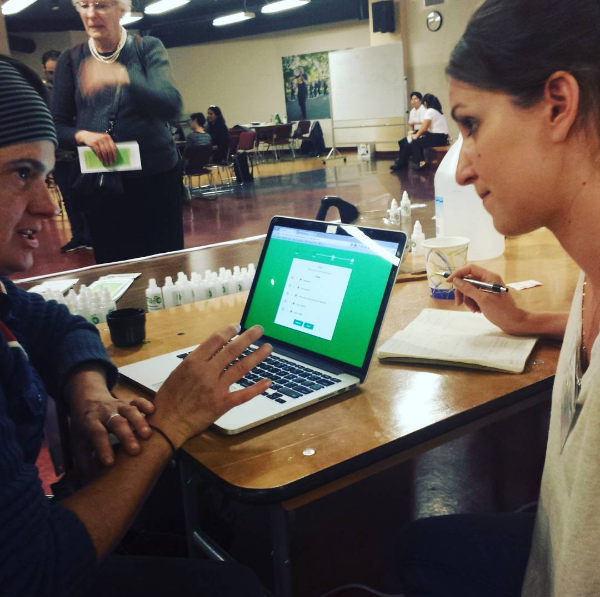This week we did user testing with cleaners on the mobile communications prototype and worked on getting everyone set up on the new Google calendaring system. We learned an immense amount from this process and emerged with many more questions than when we started.
Mobile Communications Prototype
This prototype was intended to be a low-fidelity mockup of a feature-rich, custom mobile app for Vida Verde, which honestly, we do not have the skills to fully implement. The purpose of the testing was instead to determine if the product was usable and relevant, and which of the features, if any, would be most impactful on the cleaners’ lives.
All three of the women seemed to understand how to use the prototype and how an app like it would be useful to them, and they were all extremely excited about the instant translation feature. One woman said that out of all the features, the instant translation would be the most useful, one said the calendar (especially with something that added up her income every month), and one said everything would be useful. One woman mentioned, and the others agreed, that the “Useful Phrases” screen is nice but also not particularly helpful since most of the phrases that would be on that screen are phrases they would have already learned.
Coming out of this, and knowing our limitations, we decided initially to focus on an all-sms version of the app that simply provides an automatic Portuguese translation of every text from a client, using the Twilio API for programmable SMS, and the IBM Watson Language Translation API for translation. However, upon further discussion, we came to understand that even if we are able to build a webapp to perfectly route and translate messages, we are not able commit to maintaining it for Vida Verde indefinitely, nor will we be solving a major business need. Although the translation feature was attractive to our users, it’s unclear whether that would lead to more direct communication between clients and cleaners, which is our main goal here. Also, most importantly, coordination and upkeep of the webapp connecting clients and cleaners might paradoxically lead to more work, not less, for coordinators.
We tabled the idea of a translation app, but are still left with the open question of whether outward facing hype is enough reason to keep developing the prototype in parallel to our actually implementable projects. If we cannot build it, is it worth it to create something inspirational, or to synthesize what we have learned into a clickable prototype that perhaps someone else could learn from and build?
Calendaring
While we had a few cleaners together, we also worked on getting everyone set up on shared calendars. This was both practical, and user testing for the platform. We immediately ran into great deal of (significant, though nor insurmountable) obstacles:
- To access the shared calendar system, each of the cleaners needs to download the Google Calendar app onto their phones (and have smart phones, which all the cleaners do). One cleaner was not able to do this step because she lost her credit card, and even though the Google Calendar app is free, the App Store requires a credit card to use.
- To use Google Calendar, each of the cleaners needs to have a Gmail account. At least one cleaner only had a Hotmail account, so Tais will be helping her and others get Gmail accounts, at least for the purposes of using the calendar.
- In order to share a calendar, an administrator needs to open up permissions for the organization so that people “outside the organization” (i.e. cleaners with @gmail.com instead of @vidaverdecoop.com emails) can modify calendars.
- We invited one cleaner to an individual cleaning as a “guest,” and that seemed to work for automatically adding it to her calendar. In the past week since we did this, it has worked well for her.
In conclusion, it seems like the calendaring system will work for sharing schedules, addresses and contact information for clients, how much each client is expected to pay, appointment reminders, and notes on each house, though there are some big hurdles at the start for standardizing it between cleaners.
SEO
Early on, we decided to focus on internal coordination at Vida Verde, but unfortunately this has caused us to lose sight of their web presence. We recently realized that it is extremely difficult to find
Vida Verde’s website from a Google search (though it is relatively easy to find their blog, which doesn’t link to the website). In place of the communications prototype, which is now tabled, we will start working on rectifying this situation by doing a URL redirect from their blog, including a link to their website on the blog, or implementing better SEO for the main site.
Quote Widget
We conducted more user interviews on
the prototype! Also, we’re currently trying to get in touch with the woman who developed the website to see about making a javascript widget.
In conclusion, we had a very productive week, and learned a great deal about the directions we think are best to go with this project.

